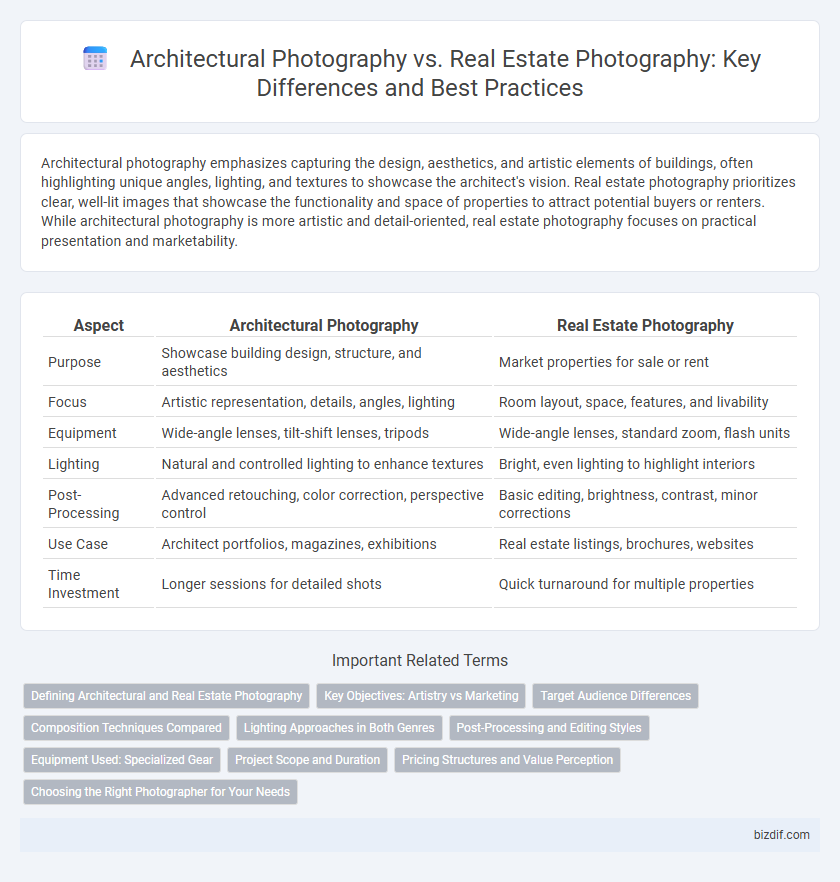Architectural photography emphasizes capturing the design, aesthetics, and artistic elements of buildings, often highlighting unique angles, lighting, and textures to showcase the architect's vision. Real estate photography prioritizes clear, well-lit images that showcase the functionality and space of properties to attract potential buyers or renters. While architectural photography is more artistic and detail-oriented, real estate photography focuses on practical presentation and marketability.
Table of Comparison
| Aspect | Architectural Photography | Real Estate Photography |
|---|---|---|
| Purpose | Showcase building design, structure, and aesthetics | Market properties for sale or rent |
| Focus | Artistic representation, details, angles, lighting | Room layout, space, features, and livability |
| Equipment | Wide-angle lenses, tilt-shift lenses, tripods | Wide-angle lenses, standard zoom, flash units |
| Lighting | Natural and controlled lighting to enhance textures | Bright, even lighting to highlight interiors |
| Post-Processing | Advanced retouching, color correction, perspective control | Basic editing, brightness, contrast, minor corrections |
| Use Case | Architect portfolios, magazines, exhibitions | Real estate listings, brochures, websites |
| Time Investment | Longer sessions for detailed shots | Quick turnaround for multiple properties |
Defining Architectural and Real Estate Photography
Architectural photography captures the artistic essence and intricate design details of buildings and structures, emphasizing form, texture, and composition to highlight architectural style. Real estate photography focuses on showcasing properties for sale or rent, aiming to present interior and exterior spaces attractively to potential buyers through well-lit, wide-angle shots. Both genres require specialized techniques, but architectural photography prioritizes aesthetics and design, while real estate photography centers on marketing and functionality.
Key Objectives: Artistry vs Marketing
Architectural photography emphasizes capturing the aesthetic essence and design details of buildings, showcasing artistic creativity and visual storytelling through composition, lighting, and perspective. Real estate photography focuses on highlighting property features to attract potential buyers, prioritizing clarity, space, and appeal to facilitate marketing and sales. Both disciplines use professional techniques but serve distinct purposes: artistry in architectural photography versus promotional effectiveness in real estate photography.
Target Audience Differences
Architectural photography targets architects, designers, and magazines seeking artistic and technical representation of buildings that emphasize design details and aesthetics. Real estate photography aims at potential homebuyers and real estate agents by showcasing properties in a way that highlights livability and market appeal. The distinct focus drives differences in composition, lighting, and presentation tailored to each audience's specific needs.
Composition Techniques Compared
Architectural photography emphasizes precise composition techniques such as leading lines, symmetry, and perspective control to highlight building design and structural details, often using tilt-shift lenses to prevent distortion. Real estate photography prioritizes wide-angle framing and efficient space utilization to showcase interior layouts and maximize room size appeal for potential buyers. Both disciplines require careful lighting management but differ in compositional goals--architectural photography aims for artistic representation, while real estate photography focuses on functional and inviting presentations.
Lighting Approaches in Both Genres
Architectural photography emphasizes natural and ambient lighting to capture the design's intricate details and textures, often utilizing golden hour or diffused daylight for dramatic shadows and depth. Real estate photography focuses on balanced, even lighting with artificial sources and flash to showcase interior spaces clearly and attractively, minimizing shadows for a clean, inviting look. Both genres require strategic lighting setups, but architectural photography leans toward artistic expression, while real estate photography prioritizes functional brightness and clarity.
Post-Processing and Editing Styles
Architectural photography often emphasizes precision and artistic composition, using advanced post-processing techniques like perspective correction, high dynamic range (HDR) blending, and subtle color grading to highlight structural details and design elements. Real estate photography prioritizes bright, evenly lit interiors with wide-angle lens effects, employing editing styles that enhance brightness, saturation, and sharpness to create inviting, expansive room views. Both genres utilize software tools such as Adobe Lightroom and Photoshop, but architectural photography demands more meticulous adjustments for texture and geometry, while real estate editing focuses on maximizing space appeal and marketability.
Equipment Used: Specialized Gear
Architectural photography relies heavily on high-end DSLR or mirrorless cameras paired with tilt-shift lenses to control perspective and maintain straight lines, along with tripods and lighting equipment for precision. Real estate photography often utilizes wide-angle lenses, drones for aerial shots, and portable lighting kits to capture spacious interiors and highlight property features effectively. Both genres require specialized gear tailored to their unique visual objectives, reflecting the technical demands of architectural integrity versus market appeal.
Project Scope and Duration
Architectural photography involves capturing detailed design elements and artistic perspectives of structures, often requiring extensive planning and longer project duration to highlight the architect's vision. Real estate photography focuses on showcasing properties for sale or rent, emphasizing wide, clear shots that attract buyers and typically demanding quicker turnaround times. While architectural shoots may span days or weeks to capture various lighting and angles, real estate projects are usually completed within hours to meet fast-paced marketing deadlines.
Pricing Structures and Value Perception
Architectural photography typically commands higher pricing due to the specialized skills required to capture design aesthetics and lighting nuances, often involving extensive post-processing and equipment. Real estate photography, priced more competitively, focuses on quick turnaround and broad appeal to potential buyers, emphasizing room layout and staging. The perceived value of architectural photography is linked to artistic representation and portfolio enhancement, while real estate photography offers practical marketing benefits and high volume scalability.
Choosing the Right Photographer for Your Needs
Selecting the right photographer depends on your project goals: architectural photography emphasizes artistic representation and design details, ideal for architects and designers showcasing their work. Real estate photography focuses on marketing properties, highlighting space, lighting, and appeal to attract buyers quickly. Understanding the distinction ensures you hire experts skilled in either capturing structural aesthetics or maximizing a property's marketability.
Architectural Photography vs Real Estate Photography Infographic

 bizdif.com
bizdif.com